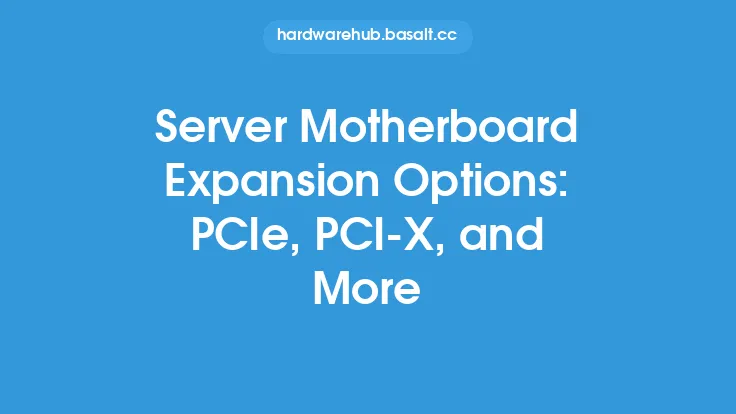When it comes to motherboards, one of the most important features to consider is the type and number of expansion slots available. These slots allow users to add various components to their system, such as graphics cards, sound cards, and network cards, to enhance its functionality and performance. In this article, we will delve into the world of motherboard expansion slots, focusing on the three main types: PCIe, PCI, and AGP.
Introduction to Expansion Slots
Expansion slots are a crucial component of a motherboard, as they provide a way to add new hardware components to a system without having to replace the entire motherboard. They are essentially slots on the motherboard that allow users to insert expansion cards, which are printed circuit boards that contain a specific component or functionality. Expansion slots have been around for decades and have evolved over time to accommodate changing technology and user needs.
PCIe Expansion Slots
PCIe (Peripheral Component Interconnect Express) is the most modern and widely used expansion slot type. It was introduced in 2004 and has since become the standard for expansion slots. PCIe slots are designed to be faster and more efficient than their predecessors, with speeds of up to 985 MB/s per lane. They are also more flexible, with the ability to be configured in various ways, such as x1, x4, x8, and x16, depending on the motherboard and the component being installed. PCIe slots are used for a wide range of components, including graphics cards, sound cards, network cards, and storage devices.
PCI Expansion Slots
PCI (Peripheral Component Interconnect) is an older expansion slot type that was introduced in the early 1990s. It was widely used in the 1990s and early 2000s but has since been largely replaced by PCIe. PCI slots are still found on some motherboards, particularly those designed for older systems or specific applications. They are generally slower than PCIe slots, with speeds of up to 133 MB/s. PCI slots are often used for legacy components, such as older sound cards or network cards.
AGP Expansion Slots
AGP (Accelerated Graphics Port) is an expansion slot type that was specifically designed for graphics cards. It was introduced in the late 1990s and was widely used in the early 2000s. AGP slots are designed to provide a high-speed connection between the graphics card and the motherboard, with speeds of up to 2133 MB/s. However, AGP has been largely replaced by PCIe, which offers faster speeds and more flexibility. AGP slots are still found on some older motherboards, but they are no longer supported by modern graphics cards.
Key Differences Between Expansion Slot Types
When it comes to choosing a motherboard, it's essential to consider the type and number of expansion slots available. PCIe slots are generally the best option, as they offer the fastest speeds and most flexibility. However, PCI and AGP slots may still be useful for specific applications or legacy components. Here are some key differences between the three expansion slot types:
- Speed: PCIe slots are the fastest, with speeds of up to 985 MB/s per lane. PCI slots are slower, with speeds of up to 133 MB/s. AGP slots are faster than PCI but slower than PCIe, with speeds of up to 2133 MB/s.
- Flexibility: PCIe slots are the most flexible, with the ability to be configured in various ways. PCI and AGP slots are less flexible, with fixed configurations.
- Compatibility: PCIe slots are the most widely supported, with compatibility with a wide range of components. PCI and AGP slots are less compatible, with limited support for modern components.
Choosing the Right Motherboard Expansion Slots
When choosing a motherboard, it's essential to consider the type and number of expansion slots available. Here are some factors to consider:
- Component requirements: Consider the components you plan to install in your system, such as graphics cards, sound cards, or network cards. Choose a motherboard with the right type and number of expansion slots to support your components.
- Future upgrades: Consider your future upgrade plans. If you plan to upgrade your system with new components, choose a motherboard with PCIe slots, which offer the most flexibility and compatibility.
- Budget: Motherboards with more expansion slots or higher-end expansion slots, such as PCIe x16, may be more expensive. Consider your budget and choose a motherboard that meets your needs and budget.
Conclusion
In conclusion, motherboard expansion slots are a crucial component of a system, providing a way to add new hardware components to enhance functionality and performance. PCIe, PCI, and AGP are the three main types of expansion slots, each with its own strengths and weaknesses. When choosing a motherboard, it's essential to consider the type and number of expansion slots available, as well as your component requirements, future upgrade plans, and budget. By understanding the different types of expansion slots and their characteristics, you can make an informed decision when choosing a motherboard that meets your needs and provides a solid foundation for your system.





